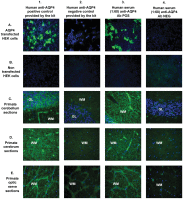Evaluation of a multiparametric immunofluorescence assay for standardization of neuromyelitis optica serology
- PMID: 22719979
- PMCID: PMC3373605
- DOI: 10.1371/journal.pone.0038896
Evaluation of a multiparametric immunofluorescence assay for standardization of neuromyelitis optica serology
Abstract
Background: Neuromyelitis optica (NMO) is a severely disabling autoimmune disorder of the central nervous system, which predominantly affects the optic nerves and spinal cord. In a majority of cases, NMO is associated with antibodies to aquaporin-4 (AQP4) (termed NMO-IgG).
Aims: In this study, we evaluated a new multiparametric indirect immunofluorescence (IIF) assay for NMO serology.
Methods: Sera from 20 patients with NMO, 41 patients with multiple sclerosis (MS), 30 healthy subjects, and a commercial anti-AQP4 IgG antibody were tested in a commercial composite immunofluorescence assay ("Neurology Mosaic 17"; Euroimmun, Germany), consisting of five different diagnostic substrates (HEK cells transfected with AQP4, non-transfected HEK cells, primate cerebellum, cerebrum, and optic nerve tissue sections).
Results: We identified AQP4 specific and non-specific fluorescence staining patterns and established positivity criteria. Based on these criteria, this kit yielded a high sensitivity (95%) and specificity (100%) for NMO and had a significant positive and negative likelihood ratio (LR+ = ∞, LR- = 0.05). Moreover, a 100% inter- and intra-laboratory reproducibility was found.
Conclusions: The biochip mosaic assay tested in this study is a powerful tool for NMO serology, fast to perform, highly sensitive and specific for NMO, reproducible, and suitable for inter-laboratory standardization as required for multi-centre clinical trials.
Conflict of interest statement
Figures




Similar articles
-
Detection of anti-aquaporin-4 antibodies in neuromyelitis optica: comparison of tissue-based and cell-based indirect immunofluorescence assays and ELISA.J Clin Lab Anal. 2012 May;26(3):184-9. doi: 10.1002/jcla.21508. J Clin Lab Anal. 2012. PMID: 22628234 Free PMC article.
-
Establishment of a new sensitive assay for anti-human aquaporin-4 antibody in neuromyelitis optica.Tohoku J Exp Med. 2006 Dec;210(4):307-13. doi: 10.1620/tjem.210.307. Tohoku J Exp Med. 2006. PMID: 17146196
-
Immunoglobulin M antibodies to aquaporin-4 in neuromyelitis optica and related disorders.Clin Chem Lab Med. 2010 May;48(5):659-63. doi: 10.1515/CCLM.2010.127. Clin Chem Lab Med. 2010. PMID: 20184532
-
Neuromyelitis optica.Curr Opin Neurol. 2007 Jun;20(3):255-60. doi: 10.1097/WCO.0b013e32814f1c6b. Curr Opin Neurol. 2007. PMID: 17495617 Review.
-
[Neuromyelitis optica and anti-aquaporin 4 antibody--an overview].Brain Nerve. 2008 May;60(5):527-37. Brain Nerve. 2008. PMID: 18516975 Review. Japanese.
Cited by
-
Mechanisms of Autoantibody-Induced Pathology.Front Immunol. 2017 May 31;8:603. doi: 10.3389/fimmu.2017.00603. eCollection 2017. Front Immunol. 2017. PMID: 28620373 Free PMC article. Review.
-
Epigallocatechin-3-gallate: a useful, effective and safe clinical approach for targeted prevention and individualised treatment of neurological diseases?EPMA J. 2013 Feb 18;4(1):5. doi: 10.1186/1878-5085-4-5. EPMA J. 2013. PMID: 23418936 Free PMC article.
-
Rituximab-induced hypogammaglobulinemia in patients with neuromyelitis optica spectrum disorders.Neurol Neuroimmunol Neuroinflamm. 2018 Sep 13;5(6):e498. doi: 10.1212/NXI.0000000000000498. eCollection 2018 Nov. Neurol Neuroimmunol Neuroinflamm. 2018. PMID: 30258855 Free PMC article.
-
Aquaporin-4 antibody titration in NMO patients treated with rituximab: A retrospective study.Neurol Neuroimmunol Neuroinflamm. 2016 Dec 15;4(2):e317. doi: 10.1212/NXI.0000000000000317. eCollection 2017 Mar. Neurol Neuroimmunol Neuroinflamm. 2016. PMID: 28054001 Free PMC article.
-
Transfection types, methods and strategies: a technical review.PeerJ. 2021 Apr 21;9:e11165. doi: 10.7717/peerj.11165. eCollection 2021. PeerJ. 2021. PMID: 33976969 Free PMC article.
References
-
- Wingerchuk DM, Hogancamp WF, O'Brien PC, Weinshenker BG. The clinical course of neuromyelitis optica (Devic's syndrome). Neurology. 1999;53(5):1107–1114. - PubMed
-
- Wingerchuk DM, Lennon VA, Pittock SJ, Lucchinetti CF, Weinshenker BG. Revised diagnostic criteria for neuromyelitis optica. Neurology 23: 66(10),1485–1489. 2006. - PubMed
-
- Lennon VA, Wingerchuk DM, Kryzer TJ, Pittock SJ, Lucchinetti CF, et al. A serum autoantibody marker of neuromyelitis optica: distinction from multiple sclerosis. Lancet. 2004;364:2106–2112. - PubMed
-
- Weinshenker BG, Wingerchuk DM, Vukusic S, Linbo L, Pittock SJ, et al. Neuromyelitis optica IgG predicts relapse after longitudinally extensive transverse myelitis. Ann Neurol. 2006;59:566–569. - PubMed
Publication types
MeSH terms
Substances
LinkOut - more resources
Full Text Sources
Miscellaneous

